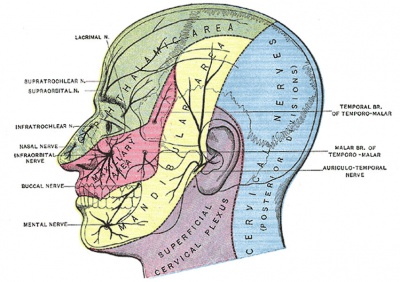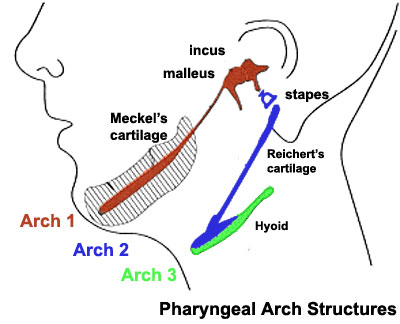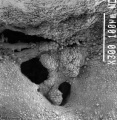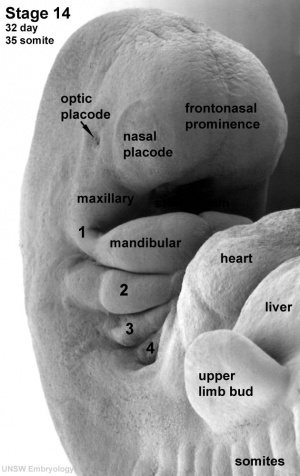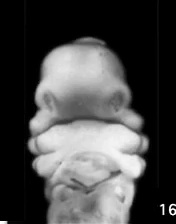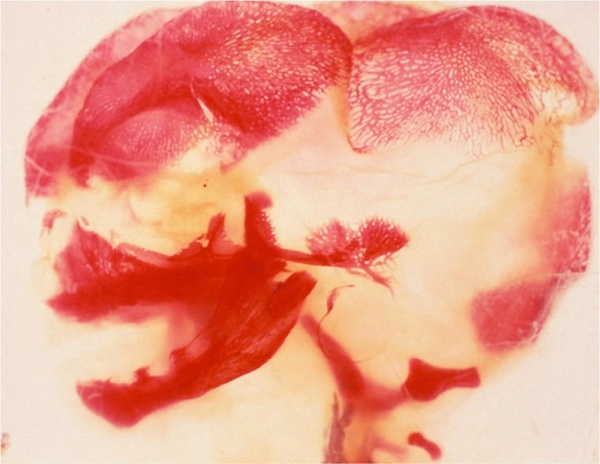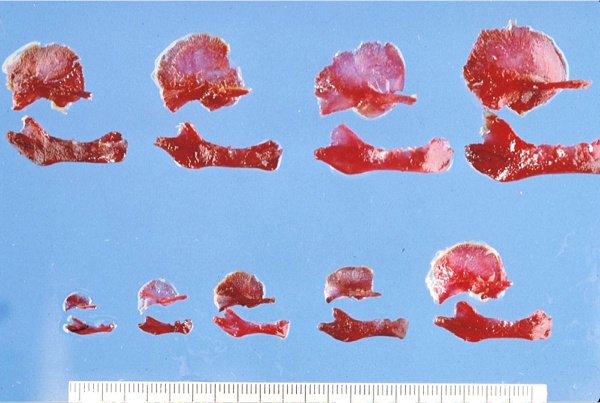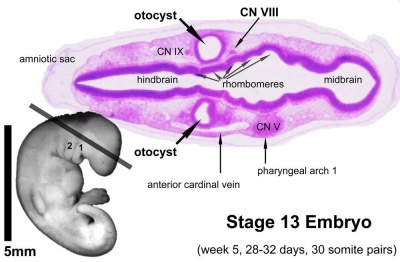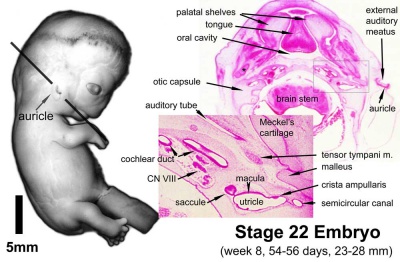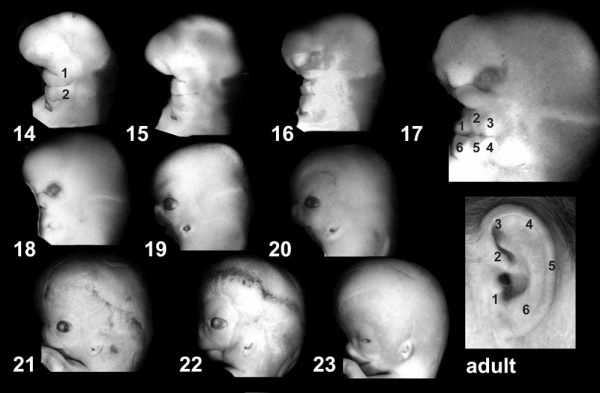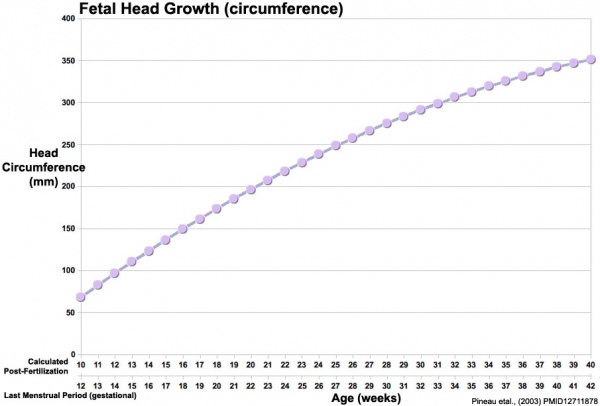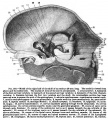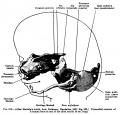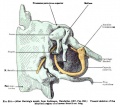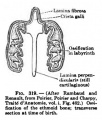AACP Meeting 2013 - Face Embryology
Face Embryology
2013 Australian Chapter, American Academy of Craniofacial Pain (AACP) Meeting May 18 May 2013
Draft Page - notice removed when complete.
Introduction
This page will be updated and contain the final conference presentation.
| <mediaplayer width='420' height='500' image="http://embryology.med.unsw.edu.au/embryology/images/3/33/Face_001_icon.jpg">file:Face_001.mp4</mediaplayer> |
Development of the Face This animation shows a ventral view of development of the human face from approximately week 5 through to neonate. The separate embryonic components that contribute to the face have been colour coded.
The stomodeum is the primordial mouth region and a surface central depression lying between the forebrain bulge and the heart bulge. At the floor of the stomodeum indentation is the buccopharyngeal membrane (oral membrane). Note the complex origin of the maxillary region (upper jaw) requiring the fusion of several embryonic elements, abnormalities of this process lead to cleft lip and cleft palate.
|
Key Concepts
Pharyngeal Arches
Arch Cartilages
Meckel's cartilage - located within the first pharyngeal arch mandibular prominence, forms a cartilage "template" besides which the mandible develops by the process of intramembranous ossification. It is important to note that this cartilage template does not ossify (endochondral ossification) but provides a transient structure where the mandible will form, and later degenerates.
Week 3
Gestational Age (GA week 5)
These images of the Stage 11 embryo show the breakdown of the buccopharyngeal membrane.
Week 4 to 5
Gestational Age (GA week 6 to 7)
Begins week 4 centered around stomodeum, external depression at oral membrane
5 initial primordia from neural crest mesenchyme (week 4)
- single frontonasal prominence (FNP) - forms forehead, nose dorsum and apex
- nasal placodes develop later bilateral, pushed medially
- paired maxillary prominences - form upper cheek and upper lip
- paired mandibular prominences - lower cheek, chin and lower lip
Week 6 to 7
Gestational Age (GA week 8 to 9)
| <mediaplayer width='320' height='420' image="http://embryology.med.unsw.edu.au/embryology/images/9/9c/Stage16-18_face_02.jpg">File:Stage16to18 face 01.mp4</mediaplayer> |
Movie shows a quick animation of the ventral views of the human embryo face, between Carnegie stage 16 to stage 18 (Week 6 to Week 7). Animation based on Kyoto embryos.
|
Week 5 to 8
Gestational Age (GA week 7 to 10)
| <mediaplayer width='380' height='400' image="http://embryology.med.unsw.edu.au/embryology/images/9/92/Stage15to22_head_icon.jpg">File:Stage15to22 head 01.mp4</mediaplayer> |
Movie shows a quick animation of the lateral view of the human embryo head, between Carnegie stage 15 to stage 22 (Week 5 to Week 8). Note that these stage images are not to scale.
|
Week 9
Gestational Age (GA week 11)
Secondary Palate Development
| <mediaplayer width='350' height='350' image="http://embryology.med.unsw.edu.au/embryology/images/4/4f/Palate_001_icon.jpg">File:Palate_001.mp4</mediaplayer> |
Animation shows an inferior view of the developmental sequence of secondary palate formation. The lower jaw has been removed and the view shows the roof of the oral cavity and the maxilla (upper jaw) and lip.
|
| <mediaplayer width='350' height='350' image="http://embryology.med.unsw.edu.au/embryology/images/a/a3/Palate_002_icon.jpg">File:Palate_002.mp4</mediaplayer> |
Animation shows an anterior view of the developmental sequence of secondary palate formation. The frontal region of the head has been removed to show the changes within the oral cavity. Secondary palate formation is the growth of the palatal shelves towards the midline, from top to bottom:
|
Week 12
Gestational Age (GA week 14)
- 12 Week Images: Sagittal unlabeled | Sagittal labeled | Sagittal medial view | Sagittal lateral view | Pituitary unlabeled | Pituitary labeled | Tongue | Skull Development | Head Development
Week 14
Gestational Age (GA week 16)
Growth of Head Structures
Maxilla
- First pharyngeal arch - upper maxillary (pair) and lower mandibular prominences
- Late embryonic period - maxillary prominences fuse with frontonasal prominence forming upper jaw (maxilla and upper lip)
- EM Links: Image - stage 16 | Image - stage 17 | Image - stage 18 | Image - stage 19 | Palate Development
Temporal Bone and Mandible
Image shows growth of both bones from the end of the embryonic period (week 8) through the fetal period of development (to 9 months).
Inner Ear
External Ear
Images of the lateral view of the human embryonic head from week 5 (stage 14) through to week 8 (stage 23) showing development of the auricular hillocks that will form the external ear.
The adult ear is also shown indicating the part of the ear that each hillock contributes.
Images are not to scale.
Head Growth
Movies
|
|
|
|
|
Histology

|
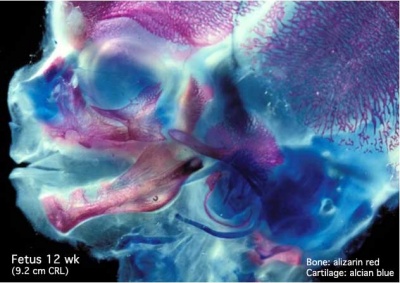
|
| Medial view | Lateral view |
Related Pages
Historic
1910 Manual of Human Embryology
Franz Keibel, Franklin P. Mall. (1910) - The The Skull, Hyoid Bone, and Larynx
1920 Contributions to Embryology Carnegie Institution No.39
Warren H. Lewis (1920) The Cartilaginous Skull Of A Human Embryo Twenty-One Millimeters In Length
1921 Contributions to Embryology Carnegie Institution No.48
Charles C. Macklin (1921) The skull of a human fetus of 43 millimeters greatest length
Glossary Links
- Glossary: A | B | C | D | E | F | G | H | I | J | K | L | M | N | O | P | Q | R | S | T | U | V | W | X | Y | Z | Numbers | Symbols | Term Link
Cite this page: Hill, M.A. (2024, May 1) Embryology AACP Meeting 2013 - Face Embryology. Retrieved from https://embryology.med.unsw.edu.au/embryology/index.php/AACP_Meeting_2013_-_Face_Embryology
- © Dr Mark Hill 2024, UNSW Embryology ISBN: 978 0 7334 2609 4 - UNSW CRICOS Provider Code No. 00098G

